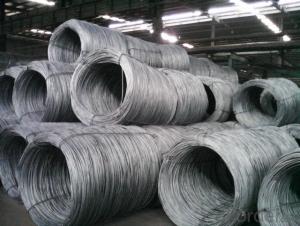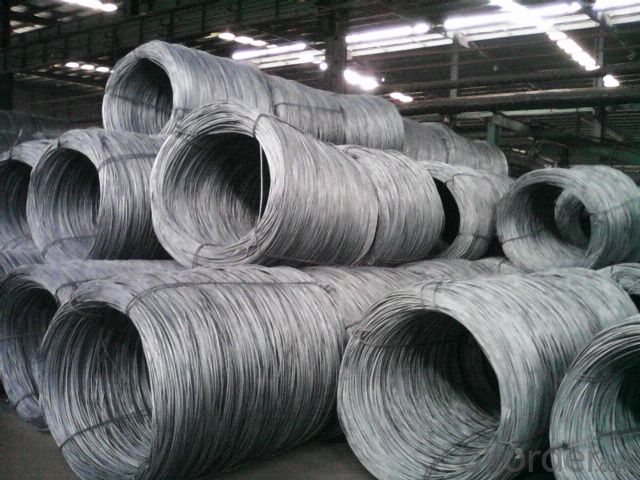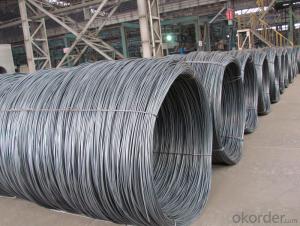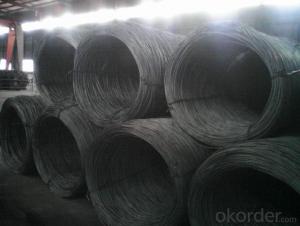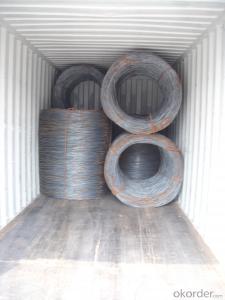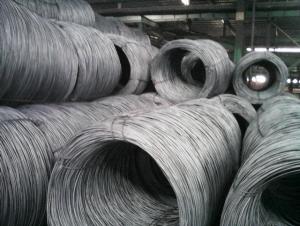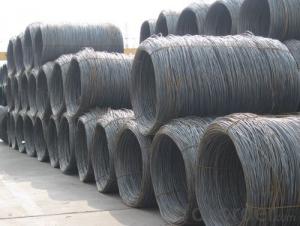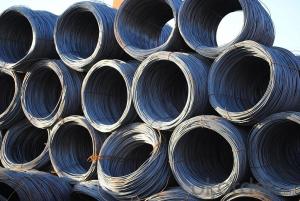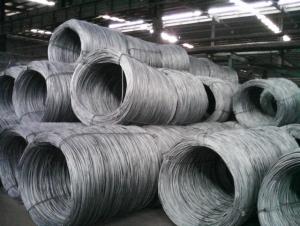Alloy Steel Wire Rods Hot Rolled Low Carbon
- Loading Port:
- China main port
- Payment Terms:
- TT OR LC
- Min Order Qty:
- 100 m.t.
- Supply Capability:
- 10000 m.t./month
OKorder Service Pledge
OKorder Financial Service
You Might Also Like
Product Description:
OKorder is offering Alloy Steel Wire Rods Hot Rolled Low Carbon at great prices with worldwide shipping. Our supplier is a world-class manufacturer of steel, with our products utilized the world over. OKorder annually supplies products to African, South American and Asian markets. We provide quotations within 24 hours of receiving an inquiry and guarantee competitive prices.
Product Applications:
Alloy Steel Wire Rods Hot Rolled Low Carbon are ideal for structural applications and are widely used in construction and manufacturing. Carbon steel wire rod is mainly used for reinforcement of reinforced concrete and welded structure or reprocessed (roberts , nail, etc.) materials, especially used to produce wire drawing, welding electrode, nails, spring, electronic, precise machinery parts and so on.
Product Advantages:
OKorder's Alloy Steel Wire Rods Hot Rolled Low Carbon are durable, strong, and wide variety of sizes.
Main Product Features:
· Premium quality
· Prompt delivery & seaworthy packing (30 days after receiving deposit)
· Can be recycled and reused
· Mill test certification
· Professional Service
· Competitive pricing
Product Specifications:
Steel Grade: SAE1006-1018B
Standard: ASTM, GB
Diameter: 5.5mm, 6.5mm, 7mm,8mm,9mm,10mm,12mm,14mm
Type: in coil, coil weight around 2MT
Alloy or Not: Alloy
Technique: Hot Rolled
Place of Origin: China Mainland
Surface: round, no twisted, light and smooth
Grade | Chemical Composition(%) | |||||
C | Mn | Si | S | P | B | |
Q195B | 0.06~O.12 | 0.25~O.50 | ≤0.30 | ≤0.050 | ≤0.045 | >0.0008 |
Mechanical properties | ||||||
Yield strength(N/mm2) | Tensile strength(N/mm2) | Elongation(%) | ||||
≥195 | 315-430 | ≥33 | ||||
Grade | Chemical Composition(%) | |||||
C | Mn | Si | S | P | B | |
Q235B | 0.12~O.2 | 0.3~O.701 | ≤0.30 | ≤0.045 | ≤0.045 | >0.0008 |
Mechanical properties | ||||||
Yield strength(N/mm2) | Tensile strength(N/mm2) | Elongation(%) | ||||
235 | 375-500 | ≥26 | ||||
FAQ:
Q1: How many tons of steel products could be loaded in containers?
A1: Usually the steel products are delivered by bulk vessel because of the large quantity and the freight. However, there are no bulk vessel enter some seaports so that we have to deliver the cargo by containers. The 6m steel product can be loaded in 20FT container, but the quantity is changed according to the size, usually from 18tons to 25tons.
Q2: How do we guarantee the quality of our products?
A2: We have established an advanced quality management system which conducts strict quality tests at every step, from raw materials to the final product. At the same time, we provide extensive follow-up service assurances as required.
Q3: How soon can we receive the product after purchase?
A3: Within three days of placing an order, we will arrange production. The normal sizes with the normal grade can be produced within one month. The specific shipping date is dependent upon international and government factors, the delivery to international main port about 45-60days.
Images:
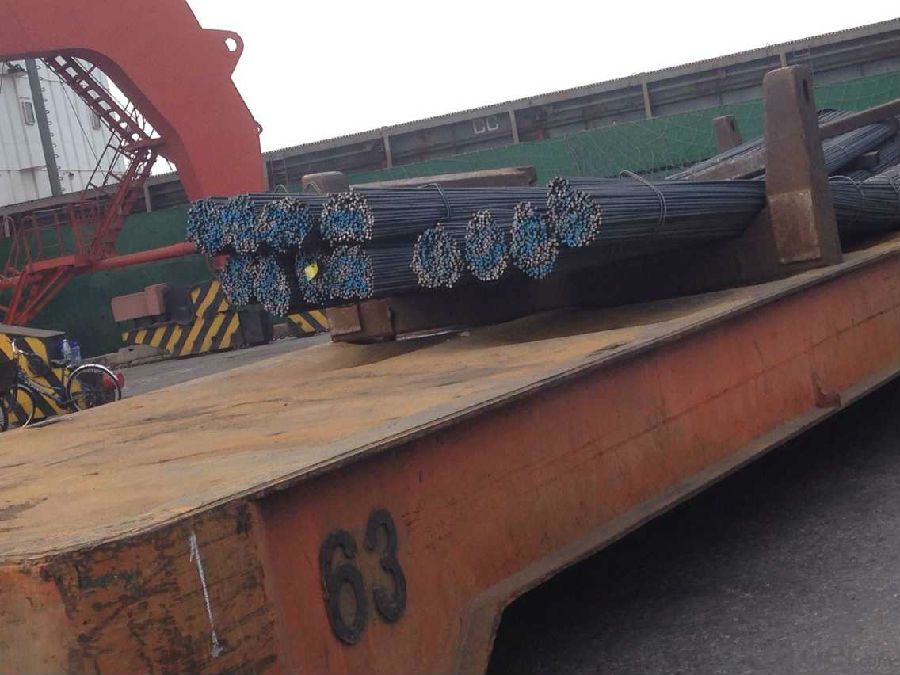
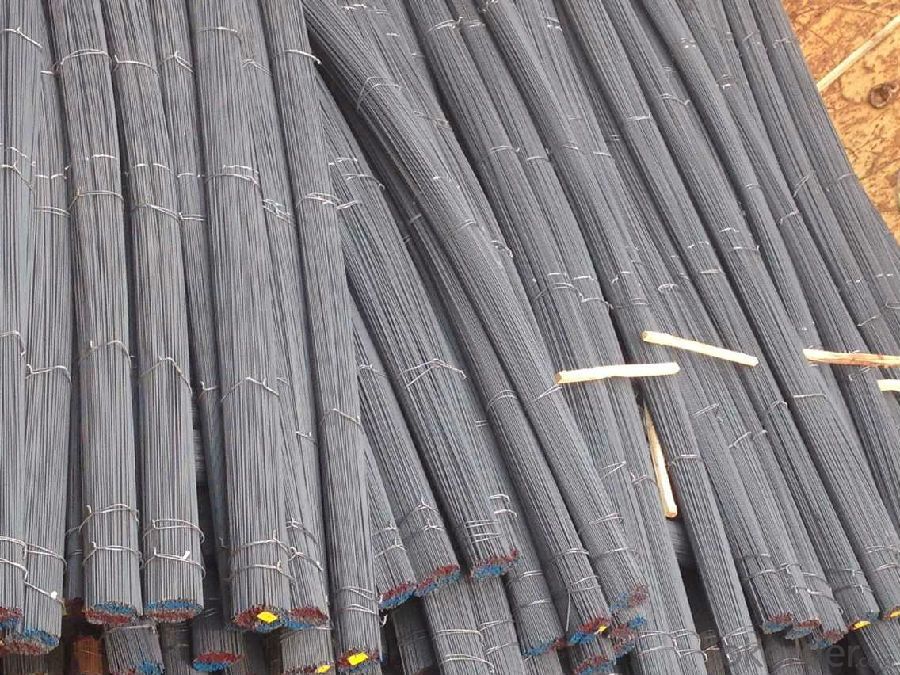
- Q: What are the different types of steel wire rod cooling methods?
- There are several different types of steel wire rod cooling methods, including air cooling, water cooling, and controlled cooling.
- Q: What are the different weldability testing methods for steel wire rod?
- There are several different weldability testing methods that can be used for steel wire rod. These methods are designed to assess the quality and suitability of the steel for welding purposes. Some of the commonly used weldability testing methods for steel wire rod include: 1. Tensile Test: This test involves applying a gradually increasing force to a welded specimen of the steel wire rod until it breaks. The tensile strength and elongation of the weld are measured to evaluate the quality of the weld. 2. Bend Test: In this test, a welded specimen of the steel wire rod is bent to a specific angle and inspected for any cracks or fractures. This test is used to assess the ductility and resistance to cracking of the weld. 3. Charpy Impact Test: This test measures the impact strength of the steel wire rod weld by striking a notched specimen with a pendulum. The energy absorbed during fracture is measured to determine the toughness of the weld. 4. Hardness Test: The hardness of the weld is often assessed using the Rockwell or Brinell hardness testing methods. This test measures the resistance of the weld to indentation, which can indicate the strength and brittleness of the weld. 5. Macroscopic Examination: This method involves visually inspecting the welded specimen of the steel wire rod for any defects such as cracks, inclusions, or lack of fusion. A magnifying lens or microscope may be used to examine the weld in detail. 6. Microscopic Examination: This test involves examining the microstructure of the weld using a microscope. The microstructure can reveal information about the grain structure, presence of impurities, and any potential weld defects. 7. Non-Destructive Testing (NDT): NDT methods such as ultrasonic testing, magnetic particle testing, or dye penetrant testing can be used to detect any internal or surface defects in the weld without damaging the specimen. These weldability testing methods help assess the quality and performance of the steel wire rod welds, ensuring that they meet the required standards for their intended applications.
- Q: What are the different types of steel wire rod coatings used for increased corrosion resistance?
- There are several types of steel wire rod coatings used for increased corrosion resistance, including zinc coating, galvanized coating, and epoxy coating. Zinc coating, also known as galvanizing, involves applying a layer of zinc to the surface of the steel wire rod through a hot-dip or electroplating process. Galvanized coating is a similar process that provides a thicker layer of zinc, offering enhanced protection against corrosion. Epoxy coating involves applying a layer of epoxy resin to the steel wire rod, which forms a protective barrier against moisture and other corrosive elements. These coatings help to extend the lifespan and durability of the steel wire rod in various applications.
- Q: What are the common applications of high carbon and oil tempered steel wire rod?
- High carbon and oil tempered steel wire rod have a wide range of applications due to their unique properties. Some of the common applications of these materials include: 1. Springs: High carbon and oil tempered steel wire rod are commonly used in the manufacturing of springs due to their excellent strength, flexibility, and durability. These materials can withstand high stress and repeated bending, making them ideal for various types of springs, including automotive suspension springs, valve springs, and mattress springs. 2. Wire ropes and cables: High carbon and oil tempered steel wire rod are also used in the production of wire ropes and cables. These materials offer high tensile strength and resistance to wear, making them suitable for applications that require heavy lifting, such as cranes, elevators, and suspension bridges. 3. Wire mesh and fencing: The strength and durability of high carbon and oil tempered steel wire rod make them ideal for manufacturing wire mesh and fencing products. These materials provide excellent security and can withstand harsh weather conditions, making them suitable for use in construction sites, agriculture, and animal enclosures. 4. Automotive applications: High carbon and oil tempered steel wire rod are widely used in the automotive industry. They are used in the production of various components, including engine valve springs, clutch springs, and brake springs. These materials offer high fatigue resistance and can withstand the demanding conditions of automotive applications. 5. Construction and infrastructure: High carbon and oil tempered steel wire rod are used in the construction industry for various applications. They are used in the reinforcement of concrete structures, such as beams, columns, and precast elements. The high strength and corrosion resistance of these materials make them suitable for withstanding the stresses and environmental conditions encountered in construction projects. 6. Industrial machinery: High carbon and oil tempered steel wire rod find applications in the production of industrial machinery and equipment. They are used in the manufacturing of conveyor belts, machine components, and wire forms. These materials provide the necessary strength and flexibility required for smooth and efficient operation of industrial machinery. In conclusion, high carbon and oil tempered steel wire rod have numerous applications across various industries. Their high strength, durability, and flexibility make them ideal for springs, wire ropes, wire mesh, automotive components, construction reinforcement, and industrial machinery.
- Q: What are the main factors influencing the choice of steel wire rod order product testing options?
- The main factors influencing the choice of steel wire rod order product testing options include quality control requirements, customer specifications, industry standards, and regulatory compliance. Firstly, quality control requirements play a crucial role in determining the testing options for steel wire rod orders. Manufacturers and suppliers often have their own quality control measures in place to ensure that the products meet the required standards. These measures may include various types of testing such as chemical composition analysis, mechanical property testing, and dimensional inspections. The choice of testing options depends on the specific quality control requirements set by the manufacturer or customer. Customer specifications also heavily influence the testing options for steel wire rod orders. Different customers may have specific requirements or preferences when it comes to the quality and performance of the product. For instance, customers in the automotive industry may have stringent specifications regarding the tensile strength or ductility of the wire rod. In such cases, specialized testing methods may be required to meet these specifications. Industry standards are another important factor in determining the testing options for steel wire rod orders. Various industry organizations and associations set standards and guidelines for the production and testing of steel wire rods. These standards ensure that the products meet the minimum requirements for safety, performance, and reliability. Testing options are chosen based on the specific industry standards that need to be met. Additionally, regulatory compliance is a significant factor influencing the choice of testing options. Steel wire rod manufacturers and suppliers must adhere to the regulations and requirements set by governmental bodies or agencies. These regulations may include specific testing protocols to ensure the safety and quality of the products. Testing options are selected accordingly to meet these regulatory compliance requirements. In summary, the main factors influencing the choice of steel wire rod order product testing options are quality control requirements, customer specifications, industry standards, and regulatory compliance. These factors ensure that the products meet the necessary quality, performance, and safety standards set by manufacturers, customers, and regulatory bodies.
- Q: What are the standard straightness requirements for steel wire rod?
- The standard straightness requirements for steel wire rod are typically specified by industry standards or customer specifications. These requirements ensure that the wire rod has a straight and uniform shape, which is crucial for its intended applications. One common straightness requirement for steel wire rod is the maximum allowable deviation from a straight line. This is usually specified as a maximum bow or camber, which refers to the amount of deviation from a straight line when the wire rod is laid flat on a surface. This requirement ensures that the wire rod can be easily processed and used in various manufacturing processes, such as drawing, cold heading, or welding. Another straightness requirement for steel wire rod is the maximum permissible twist or helix. This refers to the amount of rotation or spiral distortion along the length of the wire rod. Excessive twist can affect the wire rod's performance, especially in applications where it needs to be threaded through tight spaces or used in precision machinery. In addition to these primary straightness requirements, there may be specific tolerances for straightness at different sections or lengths of the wire rod. For example, the straightness requirement may be more stringent at the ends or along specific portions of the wire rod. These variations in straightness requirements are often determined based on the wire rod's intended application or the customer's specific needs. Overall, the standard straightness requirements for steel wire rod aim to ensure that the product meets the necessary quality standards and can be effectively used in various manufacturing processes. Compliance with these requirements helps to guarantee that the wire rod performs reliably and consistently in its intended applications.
- Q: How is steel wire rod used in the manufacturing of wire mesh baskets?
- Steel wire rod is used in the manufacturing of wire mesh baskets as it serves as the primary material for creating the wires that form the mesh. The steel wire rod is first drawn through a series of dies to reduce its diameter and increase its length. These elongated wires are then welded or woven together to form the mesh structure of the baskets. The strength and durability of the steel wire rod make it an ideal choice for withstanding heavy loads, ensuring the stability and longevity of the wire mesh baskets.
- Q: What are the main factors influencing the choice of steel wire rod order payment terms options?
- The main factors influencing the choice of steel wire rod order payment terms options can vary depending on various factors. Some of the key factors include: 1. Financial stability: The financial stability of both the buyer and the seller plays a significant role in determining the payment terms. If the buyer has a strong financial position, they may opt for more favorable payment terms such as deferred payment or letter of credit. Similarly, if the seller is financially stable, they may offer more flexible payment options to attract buyers. 2. Market competition: The level of competition in the steel wire rod industry also influences the choice of payment terms. If the market is highly competitive, sellers may offer more favorable payment terms to differentiate themselves and attract customers. Buyers, on the other hand, may negotiate for better payment terms to gain a competitive advantage. 3. Risk exposure: The level of risk associated with the transaction is another crucial factor. If there are higher risks involved, such as dealing with a new or unknown buyer/seller, payment terms may be more stringent to mitigate the risks. On the other hand, if the buyer-seller relationship is well-established and based on trust, more flexible payment terms may be agreed upon. 4. Cost of financing: The cost of financing also affects the choice of payment terms. If the cost of borrowing is high, buyers may prefer to negotiate for longer payment terms to manage their cash flow. Sellers, on the other hand, may prefer shorter payment terms to minimize their financing costs. 5. Trade regulations and customs: The payment terms can also be influenced by trade regulations and customs of the countries involved. Some countries may have specific requirements or restrictions on payment terms, such as mandatory letters of credit or advance payment. Compliance with these regulations and customs will influence the choice of payment terms. 6. Relationship and trust: The buyer-seller relationship and level of trust between the parties also play a significant role in determining the payment terms. If there is a long-standing relationship built on trust, more favorable payment terms may be agreed upon. Conversely, if there is a lack of trust or previous payment issues, more stringent payment terms may be imposed. In conclusion, the choice of steel wire rod order payment terms options is influenced by factors such as financial stability, market competition, risk exposure, cost of financing, trade regulations, and the relationship between the buyer and the seller. It is crucial for both parties to consider these factors and negotiate mutually beneficial payment terms that meet their respective needs and objectives.
- Q: How is steel wire rod transported and stored?
- Steel wire rod is typically transported and stored in large coils or bundles. These coils are loaded onto trucks, trains, or ships for transportation to various destinations. When it comes to storage, steel wire rod is often stacked in warehouses or outdoor yards, with proper measures taken to ensure stability and prevent damage. Additionally, the coils can be stored on racks or placed on flat surfaces to maintain their shape and prevent tangling.
- Q: How is steel wire rod transported?
- Steel wire rod is typically transported using various modes of transportation depending on the distance and logistics involved. The most common methods include rail, truck, and sea transportation. Rail transportation is often preferred for long-distance transportation of steel wire rods. The wire rods are loaded onto railcars either in coils or bundles, secured with straps or other fastening methods to ensure stability during transit. Rail transport provides a cost-effective and efficient means of transportation, especially for large quantities of wire rods. Truck transportation is commonly used for shorter distances or when delivery needs to be made to specific locations that are not accessible by rail. The wire rods are loaded onto flatbed trucks, either individually or in bundles, and secured with chains or straps to prevent shifting during transportation. This method allows for flexible delivery schedules and direct transport to the desired destination. For international transportation, especially for long distances across oceans, sea transportation is employed. The wire rods are usually loaded into shipping containers, either bundled or in coils, and then loaded onto cargo ships. This method enables large quantities of wire rods to be transported at once and is cost-effective for long-haul journeys. Regardless of the mode of transportation, it is essential to ensure proper packaging and securing of the steel wire rods to prevent damage or accidents during transit. Additionally, compliance with transportation regulations, such as weight restrictions and safety guidelines, is crucial to ensure smooth and safe transportation of steel wire rods.
Send your message to us
Alloy Steel Wire Rods Hot Rolled Low Carbon
- Loading Port:
- China main port
- Payment Terms:
- TT OR LC
- Min Order Qty:
- 100 m.t.
- Supply Capability:
- 10000 m.t./month
OKorder Service Pledge
OKorder Financial Service
Similar products
Hot products
Hot Searches
Related keywords
